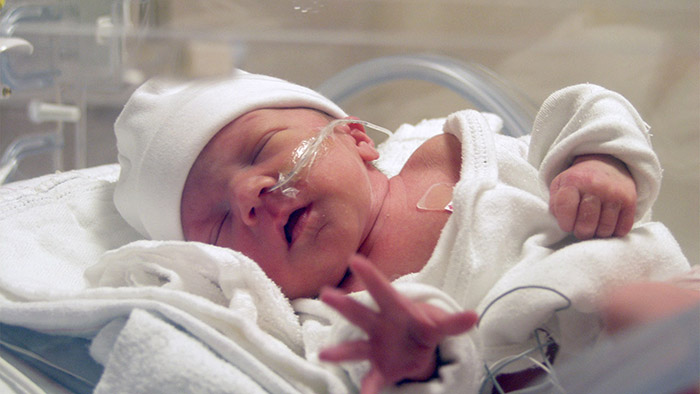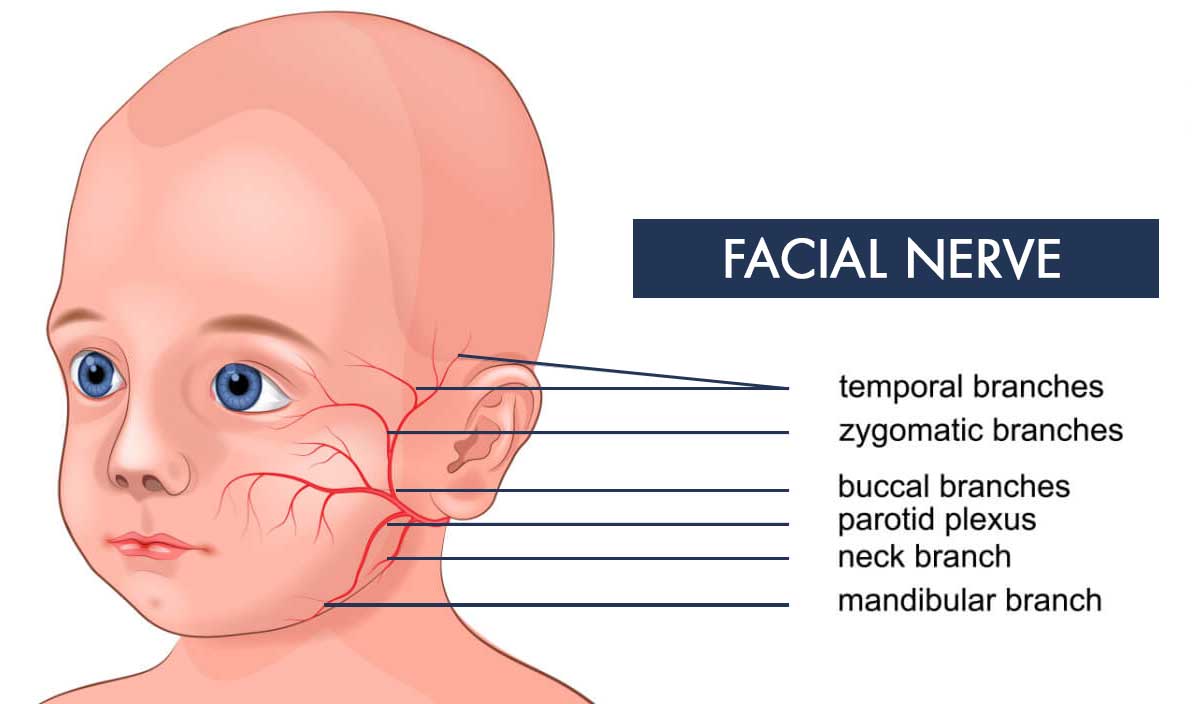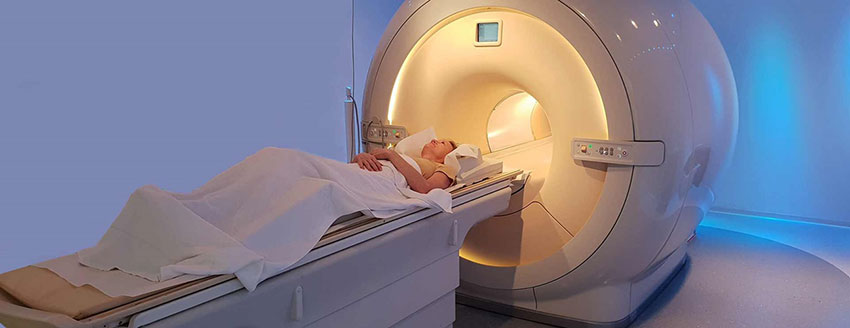Facial Paralysis - Bell's Palsy
The birth of a child should be a joyous occasion filled with love and excitement for parents and their families. However, what should be an exciting moment full of celebration can quickly turn into a nightmare if medical professionals make mistakes before, during, or after delivery.

Some of the most common birth injuries caused by the negligence of doctors, nurses, or other hospital staff are Bell's palsy and other types of facial paralysis. In fact, facial nerve palsy resulting from the use of forceps is a relatively common, with rates of occurrence reported to be between 0.8 and 7.5 cases for every 1,000 births.
Free Consultation
National Birth Injury Lawyers
1-888-987-0005
Bell's palsy is a condition that results from trauma or damage at birth to the specific cranial nerves that supply sensation and muscle control to the face. This condition causes the muscles on one side of a baby's face to suddenly become weakened or paralyzed. In cases of Bell's palsy, recovery times may vary widely.
Some babies may regain full facial muscle control within weeks or months, while others may face lasting impairments that may require ongoing therapy and medical intervention.
Depending on the severity of nerve damage, early diagnosis and treatment can significantly improve the chances of recovery. Families of children who were affected by Bell's palsy due to medical negligence should act quickly to ensure the best possible outcomes for their child's health.
At Miller Weisbrod Olesky, our experienced team of birth injury attorneys have decades of combined experience fighting for the rights of families impacted by birth injuries. We believe that every child deserves a healthy start in life, let us help you take the first step toward securing the justice and compensation your family deserves.
What is Bell's Palsy?
Bell's palsy, also referred to as facial palsy or facial paralysis, is a condition characterized by sudden weakness or paralysis of the muscles on one side of the face. In rare cases, it can affect both sides of the face. The condition is caused by damage to the 7th cranial facial nerve, which controls the muscles for facial expressions, including smiling, frowning, and blinking.

This damage leads to inflammation, preventing the facial nerve from transmitting electrical signals from the brain to the facial muscles. While the exact cause of the swelling may not always be clear, risk factors such as large baby size, prolonged labor or pregnancy, and the improper use of anesthesia or labor-inducing medications during childbirth can contribute to the development of Bell's Palsy.
Types of Bell's Palsy:
- Incomplete Bell's Palsy: This is the most common form, where either not all facial muscles are affected, or some movement remains in the affected muscles. It often causes mild weakness in areas like the eyebrow, eyelid, and mouth.
- Complete Bell's Palsy: In more severe cases, some children experience complete Bell's Palsy, where the affected facial muscles cannot move at all. These children may be unable to raise an eyebrow, close an eye, or control the muscles on one side of the mouth.
The condition may result in a noticeable facial droop or an uneven smile, with one or both eyes appearing half-closed. Children with Bell's Palsy may also drool or have difficulty drinking from a straw. They may also experience changes in taste or hyperacusis, a condition where there is increased sensitivity to sounds in the affected ear.

Facial weakness typically peaks within 24 hours of the onset of Bell's Palsy, and in many cases, it improves on its own. However, in some instances, the condition may lead to permanent paralysis and/or muscle weakness.
Additionally, if Bell's Palsy is not correctly diagnosed and treated, it can lead to serious complications, including long-term facial asymmetry or disfigurement.
Seek the care of a qualified medical professional like a pediatric neurologist as soon as possible if you notice your child exhibiting symptoms of Bell's Palsy. Prompt and appropriate treatment can help minimize the risk of permanent damage and complications.
What Causes Bell's Palsy in Infants?
Bell's palsy in infants can be caused by a variety of factors, with some being preventable and linked to medical negligence. In cases where a doctor or other healthcare provider's failure to uphold the appropriate standard of care contributes to facial nerve damage, affected families may be able to pursue a malpractice claim to recover damages for their child's ongoing medical care and treatment needs.
Some of the most common preventable medical errors that cause damage to the seventh cranial nerve during childbirth include:
- Failure to properly monitor and treat maternal infections: Maternal infections such as herpes simplex virus (HSV), herpes zoster (shingles), Epstein-Barr virus (EBV), influenza B (flu), Lyme disease, and rubella (German measles) can lead to Bell's Palsy in the infant. A healthcare provider should screen for these infections during prenatal care and take necessary steps to minimize the risk of transmission to the baby.
- Birth trauma during delivery: Birth injuries, from birth trauma such as skull fractures is a leading cause of Bell’s palsy. Birth injuries such as intracranial hemorrhage, and spinal cord injuries, can potentially be caused by mistakes made when a doctor either manually extracts a baby from the birth canal or uses medical instruments like forceps or a vacuum extractor improperly.

The forceful or improper application of these instruments can cause undue pressure on the infant's head causing birth trauma like compression of the facial nerve resulting in Bell's Palsy. These birth injuries are often preventable when medical professionals adhere to proper techniques and take appropriate precautions during delivery. - Improper use of labor-inducing drugs: The use of labor-inducing drugs, like Pitocin and Cytotec, can cause the mother to experience contractions that are too strong or occur too frequently leading to birth injuries and birth trauma.
If contractions are intense or rapid, they can put excessive pressure on the infant's head during delivery causing birth trauma. This increased pressure can cause damage to the infant's delicate facial nerve, potentially leading to Bell's Palsy. Additionally, such forceful contractions can reduce blood and oxygen flow to the baby, increasing the risk of other birth complications, such as hypoxic-ischemic encephalopathy (HIE) and cerebral palsy (CP). - Failure to treat or respond to prolonged labor: If the medical team fails to monitor the progression of labor or neglects to take timely action when the delivery process takes significantly longer than usual, it can lead to severe birth complications for both the mother and infant.
Extended labor increases the risk of prolonged pressure on the baby's head, potentially leading to birth trauma resulting in the compression of the facial nerve, which can result in Bell's Palsy. Additionally, prolonged labor can lead to significant fetal distress for the baby, restricting oxygen supply and increasing the risk of neurological birth complications.
It is essential for medical professionals like obstetricians and labor and delivery nurses to closely monitor the labor process and intervene as necessary to ensure a safer delivery for both the mother and child. - Failure to identify maternal and fetal risk factors: Maternal risk factors, such as pre-existing conditions like diabetes, high blood pressure, or infections, can affect the course of labor and the health of the infant.
Similarly, fetal risk factors should be monitored throughout pregnancy and delivery, including the baby's size, position, or gestational age. For instance, a baby who is larger than average (macrosomia) or in an abnormal fetal position (such as breech) is at higher risk of birth injuries, including nerve damage like Bell's Palsy.
When doctors like obstetricians and maternal fetal specialists fail to properly assess these risk factors and take appropriate precautions, such as preparing for a possible emergency C-section, it can result in prolonged labor, excessive pressure on the baby's head, or physical birth trauma during delivery. - Failure to respond to signs of fetal distress: If doctors and other medical professionals fail to respond to signs of fetal distress (i.e. abnormal heart rate, lack of movement, or decreased oxygen levels), it can result in severe birth injuries for the baby. Signs of fetal distress are indicators that the baby may be experiencing a lack of oxygen, excessive pressure, or other complications that can lead to birth injuries.
- Failure to intervene appropriately: Performing an emergency C-section, repositioning the mother, or administering oxygen to the baby in a timely manner can increase the risk of birth injuries, including Bell's Palsy.
If your infant has been diagnosed with a birth complication of Bell's Palsy and you suspect could have been prevented with proper medical care, you owe it to yourself and your child to seek further guidance and consult with an attorney who can help you understand your legal options.
An experienced birth injury lawyer will investigate the circumstances surrounding your child’s birth, determine if medical negligence played a role, and protect your rights to compensation for any harm caused.
How Common Is Bell's Palsy?
Approximately 1 in 70 people will develop Bell's Palsy, with nearly 40,000 people in the US being diagnosed with the condition each year. The right side of the face is affected more often than the left, occurring in 63% of cases. Recurrence of Bell's palsy is possible in 4 to 14% of cases and is more common in patients with diabetes.
Other risk factors include the presence of the herpes virus and existing health conditions such as the flu, a cold, high blood pressure, or hypothyroidism. Though treatment for the herpes virus during pregnancy is limited due to potential risks to the baby, untreated cases can lead to paralysis in newborns.

In newborns, Bell's Palsy can occur in up to 7.5 out of every 1,000 births. This birth trauma risk increases to 8.8 per 1,000 births when forceps are used during delivery. Fortunately, most cases in infants resolve without treatment, with children regaining facial muscle control as the cranial nerve recovers. On average, recovery takes around 24 days, though in some cases, it may take a few months for the child to make full recovery.
In severe cases, Bell's palsy can cause permanent damage, such as vision impairment or full or partial blindness. Given its potential long-term effects on both individuals and newborns understanding the risk factors and potential birth complications associated with Bell's Palsy is essential for early detection and intervention.
Diagnosis and Management of Bell's Palsy
There are no specific tests for diagnosing Bell's Palsy. Healthcare providers will often rely on examining a patient's face and recognizing the characteristic signs of facial weakness to make a diagnosis.
In infants, doctors typically look for symptoms such as abnormal facial expressions, excessive drooling, and signs of pain and dizziness. A doctor will also take the patient's medical history and perform a physical examination to help confirm the diagnosis and rule out other potential causes of facial paralysis.
If a doctor suspect there may be another more serious condition, like a stroke or a brain tumor causing facial paralysis, they may recommend additional tests.

The following diagnostic neuroimaging tests may be ordered to ensure an accurate diagnosis and guide appropriate treatment of Bell’s palsy:
- MRI (Magnetic Resonance Imaging): An MRI scan provides detailed images of the brain and soft tissues and helps doctors identify whether the patient suffered birth trauma such as a skull fracture, or something else causing facial drooping or swelling.
- CT scan (Computed Tomography): CT scans may be used to examine bone structures, such as the skull, to check for fractures or conditions that could affect the facial nerve.
- Electroencephalogram (EEG): An EEG can be used to evaluate and measure the electrical activity along the facial nerve pathways to ensure that the nerves function properly and effectively transmit signals to the facial muscles.
- Electromyography (EMG): An EMG test helps confirm Bell’s palsy if there has been nerve damage to the facial nerve and assesses the extent and severity of the damage. This test measures the electrical activity of the facial muscles in response to stimulation. During the procedure, electrical impulses are sent into the nerve, and the EMG evaluates how well the muscles respond to the signals.
- Blood and Spinal Fluid Tests: Blood tests can help identify underlying infections or autoimmune conditions contributing to Bell's Palsy, such as viral or bacterial infections. In rare cases, a spinal fluid test may be performed to check for inflammation or infection affecting the nervous system.
Treatment and Management of Bell’s Palsy
Most patients with Bell's palsy will fully recover 70-80% of the time without treatment. However, some doctors may recommend further intervention if improvement does not occur, or the symptoms are progressive.

The primary treatment options are generally conservative and may include:
- Medications: A doctor may prescribe corticosteroids, such as prednisone, to reduce inflammation and swelling of the facial nerve. These are most effective in treating Bell’s palsy when started early, ideally within 72 hours of symptom onset. If a viral infection, such as the herpes simplex virus, is suspected of causing the Bell’s palsy, antiviral medications like acyclovir or valacyclovir may be prescribed alongside corticosteroids.
- Physical Therapy: Facial nerves can become paralyzed if not regularly moved, leading to muscle weakness and atrophy in children suffering from Bell’s palsy. Physical therapists may use various techniques, including massage and targeted facial exercises, to stimulate the affected muscles and improve function. For some patients, especially children, physical therapy may be required over an extended period of time to ensure that the muscles stay strong and flexible.
- Eye Protection: In cases where a Bell’s palsy child has a difficult time closing their eye, protection is crucial to prevent dryness or irritation. This may involve using lubricating eye drops, applying ointments, or wearing an eye patch to protect the exposed eye.
- Botox Injections: In Bell’s palsy cases of persistent facial muscle weakness or asymmetry, botulinum toxin (Botox) injections may be used to relax facial muscles and improve appearance. However, this is typically only considered after other treatment options have been exhausted.
In rare and severe cases of Bell's palsy, surgical interventions may be considered. For example, a total or partial surgical closure of the eyelid on the affected side can be performed to prevent permanent eye damage.
In Bell’s palsy cases of long-lasting facial nerve issues, plastic surgery or decompression surgery may be considered. Decompression surgery involves removing bone or soft tissue that may be pressing on the facial nerve to relieve pressure and restore function.
While it can provide relief, the procedure carries significant risks, and many medical professionals believe the risks often outweigh the benefits.
What are the Symptoms of Bell's Palsy?
Bell's palsy causes facial nerve damage that can lead to a variety of symptoms. These symptoms range from mild weakness to complete paralysis of facial muscles, typically on one side of the face.

While Bell’s palsy symptoms may vary depending on severity, the most common include:
- Twitching, weakness, or paralysis on one side of the face (both sides of the face may be affected in some cases)
- The corner of the mouth or eyelid may droop
- Difficulty with smiling, closing the eye on the affected side, or raising the eyebrow
- The affected eye may either produce too many tears or become excessively dry
- Increased sensitivity to loud noises may occur in the affected ear
- Difficulty controlling facial muscles may make it harder to chew or drink
Bell's palsy symptoms are often immediately noticeable in infants, especially when they cry or move their mouths.
Some signs of Bell’s palsy in children may include:
- A noticeable droop on one side of the face
- Problems latching or drinking from a bottle
- Excessive drooling due to reduced muscle control
- The face may not move symmetrically
Bell's palsy is usually not permanent, with most children fully recovering within two to three months. However, if significant improvement has not occurred by four months, further evaluation may be needed to avoid delayed treatment for Bell’s palsy complications such as prolonged nerve dysfunction or eye damage.
For instance, the inability to blink properly on the affected side, though rare, can lead to eye dryness or damage. This can result in serious birth complications, including vision loss if left untreated.
Additionally, while rare, some children may experience permanent nerve damage. This can cause persistent muscle weakness or hinder the full recovery of facial movement.
Filing a Birth Injury Lawsuit

A birth injury lawsuit is a type of legal action that a parent may file on behalf of a child against negligent doctors, hospitals, or other healthcare professionals for causing the child to suffer a preventable birth injury. Through a birth injury lawsuit, families can recover compensation to help ease the financial burden of covering their child's treatment and care costs.
While each case is different, most lawsuits generally follow the same process. A lawyer with experience in birth injury cases can file your case, gather evidence, and pursue full and fair compensation on your behalf.
Here's how our birth injury attorneys will support you through the entire lawsuit process:
Free Case Review
After getting in contact with one of our birth injury lawyers, you will have your free consultation, where we'll determine if you may be eligible to file a birth injury lawsuit. Your case will likely be accepted if we can determine that medical malpractice may have played a role in your child's birth injury.
Gather Evidence
As soon as you qualify for a lawsuit, your birth injury malpractice attorney will gather information and evidence related to your case to build a strong claim. In proving a child's birth injury was caused by medical negligence, critical pieces of evidence like medical records, witness statements, and the employment history of the medical professional in your case are crucial to filing a successful lawsuit.
File the Lawsuit
Once all initial information has been gathered, your birth injury attorney will file your lawsuit in the proper court of law. You and your family will become the plaintiffs (the party taking legal action) as soon as the case is filed.
The medical providers whose conduct may have caused your child harm will become the defendants (the party being sued). Every state has a deadline for filing a birth injury lawsuit, also known as the statute of limitations.
Your lawyer will be mindful of your state's statute of limitations and ensure your case is filed on time. The lawsuit will outline the charges in the lawsuit and give the defendants around 30 days to respond.
If the defendants fail to respond, judgment can automatically be entered for the plaintiff. If the defendants send a response but fail to take responsibility, they will explain why they believe they are not at fault for your child's injury.
Discovery
As soon as the defendants file a response, your dedicated birth injury attorney will gather more evidence, such as additional medical records, medical expense reports, and other documents related to your child's birth injury to strengthen your case.
You, your loved ones, and medical experts may have to give statements or answer questions under oath during this time. Both parties will also exchange information and evidence relevant to their respective cases to build strong arguments.
A skilled attorney can pursue the legally required evidence to prove that the medical professionals did not uphold a high standard of care.
Settlement Negotiations
Once both sides prepare their case, settlement negotiations may begin. The goal of this phase is for both parties to reach an official agreement (settlement) that resolves the dispute without going through the time and expense of a full trial.
The defendants will agree to pay a lump sum of money to you if the lawsuit reaches a settlement and all legal action stops. Our lawyers are prepared to represent your best interests in court if your case is unresolved during this phase.
Go Through a Trial
A case will proceed to trial if it is not resolved in settlement negotiations. During a trial, a judge and jury will hear arguments from both legal teams and examine all the evidence presented by each party.
A verdict is reached once each side has had the opportunity to present their cases and a judgment entered.
In some cases, the losing side may appeal the decision. Additionally, although trials may award you with more compensation than a settlement, you risk receiving no financial compensation at all if you lose. Let our lawyers help you win the compensation you need to help pay for the cost of your child's care.
Birth Injury Malpractice in Bell’s Palsy Cases

When a doctor makes a mistake or is negligent while delivering a baby, the result is often an injury to a mother, her child, or both. Although not all birth injuries are indicative of medical malpractice, an attorney can ensure that if your provider was negligent in your child's care, you get the compensation you deserve.
Common Examples of Medical Negligence During Childbirth causing Bell’s Palsy
- Improper use of forceps or a vacuum extractor
- Using too much force during delivery
- Failure to schedule an emergency cesarean section (C-section)
- Delaying in performing an emergency C-section
- Failure to properly monitor the mother during her pregnancy
- Failure to administer the proper antibiotics or administering the wrong antibiotics to a mother with an STD or other maternal infections before delivery
- Ignoring or misreading a fetal heart rate monitoring strip
- Failure to recognize and treat signs of maternal or fetal distress, such as lack of oxygen
- Failure to detect and treat an umbilical cord complication
- Failure to diagnose and treat preterm labor in a timely manner
- Failure to treat maternal elevated blood pressure (preeclampsia)
- Failure to properly resuscitate a newborn after delivery
- Failure to treat jaundice and kernicterus
- Failure to respond to signs of a placental abruption
- Failure to detect a severe break defect on a prenatal ultrasound
- Failure to carefully manage an abnormal fetal position
- Administering too high of a dose of labor-inducing medications
Neglecting birth complications such as premature delivery or issues with the umbilical cord can lead to a serious birth injury that can result in lifelong challenges for the affected infant and their family.
As leaders in our communities, we place a great deal of trust in medical professionals to make the right decisions regarding our health.
While most people automatically picture doctors and nurses when medical malpractice liability comes to mind, additional parties involved who played a role in the healthcare of a pregnant woman and her baby may also be held accountable in a birth injury lawsuit.

The following types of medical providers and/ or facilities may be held responsible for committing medical negligence leading to Bell’s Palsy:
- Obstetricians (OB-GYN)
- Other obstetric professionals
- Pediatricians, including pediatric neurologists
- Anesthesiologists
- Labor and delivery nurses
- Midwives
- Nurses
- Hospitals and medical facilities
- Hospital administrators
- Other hospital staff
- Neonatal nurses and aids
- Neonatologists or pediatricians providing neonatal care
- Respiratory therapists
- Maternal-fetal medicine physicians and specialists (MFM)
- Laboratory staff
While healthcare providers like doctors and nurses are often the ones medical malpractice suits are brought against, there are times when a hospital could also be held responsible. A hospital can be vicariously liable for an employee's negligent actions that caused harm during work hours or while the employee was performing a job-related task. For example, a hospital may be held vicariously liable for the negligent mistakes of an OBGYN during a patient's pregnancy or delivery.
A hospital may also be held directly liable for its own actions. For instance, hospitals may face direct liability for a patient injury caused by a failure to establish and adhere to medical protocols and standards.
Whether it was a doctor, the hospital itself, or another medical professional, we can help you determine the cause of your child's injury during birth and hold healthcare providers accountable for their actions.
When you file a birth injury claim, your lawyer must be prepared to present evidence that proves that a doctor's or hospital's negligence caused your child's birth injury. In a birth injury lawsuit, the plaintiff must be able to prove each of the following four legal elements.
- Duty of Care: Before the provider will have a duty of care, the plaintiff must be able to establish a provider-patient relationship. Upon establishing this relationship, the medical provider is expected to meet a relevant standard of care that a medical professional with the same specialization would have exercised under the same conditions.
- Breach: The next element the plaintiff must prove is that the healthcare provider or facility breached that duty by failing to meet the applicable standard of care.
- Causation: The plaintiff must then demonstrate that the healthcare provider's negligent care directly caused their or their child's injuries.
- Damages: Finally, the plaintiff must show that the harm they or their child suffered resulted in specific expenses and other losses. These losses may include anything from the cost of lifelong medical care to emotional suffering.
In birth injury cases, compelling evidence must be presented by the plaintiff's attorney to establish liability and secure damages.
The birth injury lawyers at Miller Weisbrod Olesky can collect evidence on your behalf, consult with medical experts to determine the cause of the injury, and identify all negligent medical professionals who contributed to you or your child's birth injury.
Recoverable Damages Available in a Birth Injury Lawsuit
When a doctor or hospital's negligence, wrongful action, or lack of action before, during, or after childbirth results in injuries to you or your child, you may be entitled to seek financial compensation.

Damages in birth injury lawsuits generally fall into two categories: economic and non-economic. Economic damages refer to the financial losses you've sustained due to the injuries you or your child suffered. Non-economic damages refer to subjective, monetary losses and are meant to compensate the victim for pain and suffering experienced as a result of the birth injury.
Economic Damages
- Medical expenses (including the cost of any future medical care)
- The cost of any medications or surgeries
- Rehabilitation and therapy costs (occupational, physical, and speech therapy)
- Lost income or wages of parents (including future loss of income)
- The cost of assistive devices like wheelchairs or communication aids
- Lost future earning capacity (if the child's birth injury impacts the child's ability to work in the future)
- The cost of special education services and tutors
- Home modification costs (such as ramps or accessible bathrooms)
- The cost of assistive devices
- Costs associated with a caregiver or home nurse
Non-Economic Damages
- Physical pain and suffering
- Reduced quality of life
- Disfigurement and permanent scarring
- Emotional or mental anguish
- Paralysis, scarring, and disfigurement
- Post-traumatic stress disorder (PTSD)
- Loss of consortium
Punitive or Exemplary Damages may be awarded in addition to economic and non-economic damages. These damages are often difficult to prove and only awarded in cases where the medical professional's behavior is intentional or especially negligent. Punitive damages are intended to punish the at-fault party and deter others from committing similar wrongful behavior.
The settlement award you may receive will depend on various factors, including the nature and severity of your child's condition, the impact of the injury on the child's quality of life, and the financial damages you have suffered. A dedicated birth injury lawyer can help you prove all your damages and calculate the potential value of your medical malpractice settlement.
Birth Injury Lawsuit Statute of Limitations

Statutes of limitations (SOL) are established by law in each state and dictate the time-frame within which a personal injury lawsuit must be initiated. Typically, the countdown begins on the date of the injury.
However, the discovery rule provides an exception to this rule in cases where the injury was not immediately apparent. Under this rule, the clock doesn't start ticking until the injured person discovers or reasonably should have discovered their injury.
This can be confusing, so it's advisable to contact a knowledgeable birth injury attorney to discuss your and your child's legal rights and options.
According to Chapter 74 of the Texas Civil Practices & Remedies Code, there are several deadlines for filing a birth injury case in the state.
These include:
- For damages (other than medical expenses) incurred until age 18, a lawsuit must be filed by the time the child turns 14.
- To recover medical expenses for the child from birth until age 18, the lawsuit must be filed within two years of the date of the accident.
If the statute of limitations expires in your case, you may lose the opportunity to seek compensation. A medical malpractice lawyer can determine the specific deadlines that apply to your unique situation and ensure paperwork is filed on time.
Get Help from a Dedicated Team of Birth Injury Lawyers

If you suspect that a doctor's negligence contributed to your child suffering preventable harm before, during, or after delivery our team of dedicated birth injury lawyers is here to help.
At Miller Weisbrod Olesky, we understand the obstacles families face in the aftermath of a devastating birth injury. Navigating the complexities of a medical malpractice case while managing the emotional and financial challenges of a birth-injured child's care can be overwhelming.
We believe that victims of medical negligence deserve to have their voices heard and are committed to utilizing our extensive experience and resources to securing the justice birth injured children and their families deserve.
Don't go through this process alone; let us be your trusted advocate. We work on a contingency fee basis, meaning you pay nothing unless we win your case. Take the first step toward justice and schedule your free, no-obligation consultation today by calling us at 888-987-0005 or filling out our convenient online form.
